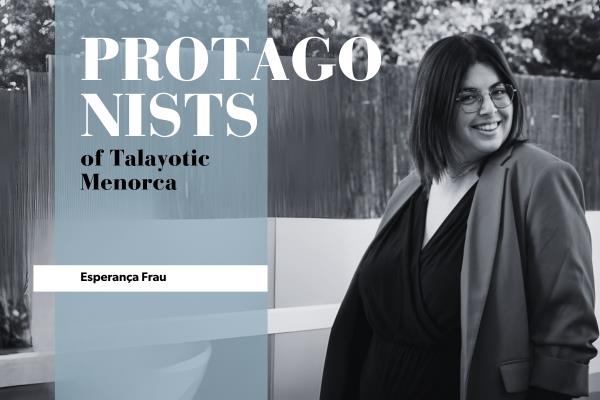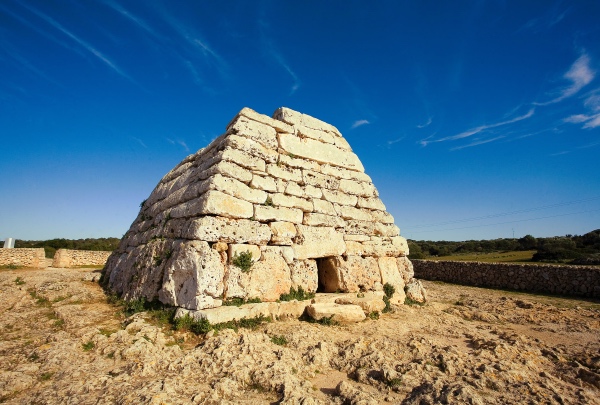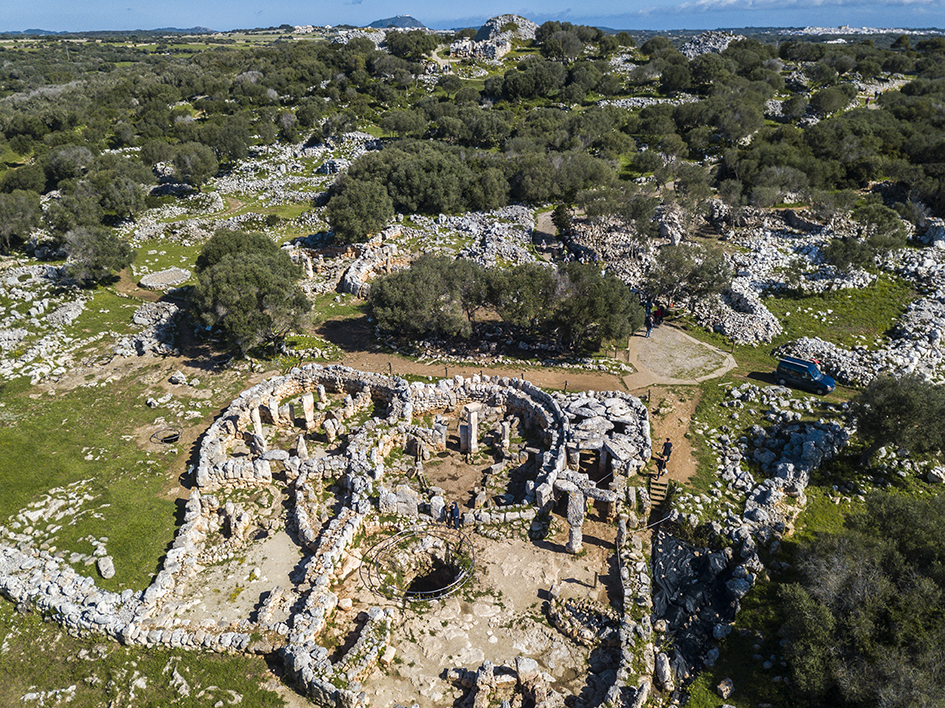
Esperança Frau Anglada was born in Ciutadella de Menorca in 1997. She completed a Higher Vocational Training in Early Childhood Education at La Salle de Palma and later pursued a Dual Degree in Early Childhood and Primary Education with specializations in English and Therapeutic Pedagogy at CESAG, an affiliate center of the Pontifical University of Comillas.
During her time in Mallorca, she obtained certifications as a Leisure Activities Instructor and Director, which allowed her to work in the non-formal education sector. This experience influenced her first Final Degree Project (TFG) on this field, solidifying her interest in education and cultural heritage.
Her training as a teacher, entirely acquired in Mallorca, introduced her to the cultural heritage of the Balearic Islands. However, it also made her realize the need to raise awareness and preserve the unique heritage of her homeland, Menorca. This sense of belonging was the inspiration for her Final Degree Project in Primary Education, titled
The Prehistoric Assets of Talayotic Menorca in Primary Education in the Island’s Schools. This research was supervised by Concepció Bauçà de Mirabò Gralla, who guided her throughout the process. With this project,
she won second place in the 2024 Feliciano Fuster Award granted by the Ateneu de Maó.
Currently, Esperança has returned to Menorca, where she works as a teacher. With a clear passion for education and heritage, she is dedicated to promoting Menorca’s historical and cultural richness through her teaching and research.
What inspired you to choose this topic for your final degree project?
Selecting the topic for my final degree project was quite challenging. There were various educational themes that caught my interest, but I decided to go with this one because I believed it was an elegant way to conclude my university journey in Mallorca: I wanted to showcase the cultural heritage of my homeland.
During my years in Mallorca, I was fortunate to learn about its cultural heritage through different friendships and teachers. The recent inclusion of Talayotic Menorca in the UNESCO World Heritage List (2023) inspired me to choose this topic. I recalled how I had been taught about Talayotic culture during my compulsory education and wanted to explore how Menorcan schools are currently working with the island’s prehistoric sites.
How do you think your sense of belonging influenced the development of this research?
On one hand, I believe my personal experience provided me with a solid foundation to begin the research. The information I had on the subject, what I had been taught in school, and the knowledge passed down by my parents were a starting point that an external researcher might not have. Additionally, I was able to better understand the unique characteristics of the island’s prehistoric sites.
On the other hand, the opportunity to share our cherished cultural heritage, even if only with my classmates or Mallorcan friends, was a great success for me. When someone asks me what they can visit in Menorca, I always explain the different archaeological sites, but I also ask them to show respect and care, as I consider these to be our most precious assets.
An important point to mention is that in March 2018, I woke up to the sad news that the Naveta des Tudons had been vandalized. This made me reflect deeply and realize that our heritage must be cared for and loved. Since then, the Naveta des Tudons has been a very special place for me. I enjoy visiting it, showing it to my friends from outside the island, and appreciating its beauty.
The declaration of Talayotic Menorca as a UNESCO World Heritage Site was the starting point of your project. How do you assess this declaration in terms of educational impact?
I believe that being included in the UNESCO World Heritage List is a great honor and privilege that not all countries have. In our case, we became the third Balearic island to enter the list, after Ibiza with its designation
Ibiza, Biodiversity and Culture as a mixed (natural and cultural) heritage in 1999, and Mallorca with its designation
Cultural Landscape of the Serra de Tramuntana in 2011.
From an educational perspective, I believe heritage should be taught in classrooms. Therefore,
teachers are responsible for educating students on how to care for and appreciate our heritage. It is important to consider that families and governmental bodies play a key role in promoting and preserving heritage. Education is a collective effort: the entire teaching staff, schools, and families must be coordinated to ensure a comprehensive education for children.
 What were the main objectives of your project?
What were the main objectives of your project?
My research was divided into two distinct parts. The first was a literature review, which allowed me to learn about sites I had not visited before, either because they were inaccessible or because I had not had the chance. The objectives of this part were:
- To introduce the Talayotic period in Menorca and the cultural heritage that represents it.
- To research the prehistoric sites of Talayotic Menorca declared UNESCO World Heritage.
- To analyze the media impact of the 2023 UNESCO declaration.
- To explore Spanish educational legislation and its implementation in classrooms.
- To identify the teaching resources available to Menorcan schools for working on Talayotic culture and heritage.
For this research, I relied on various experts, especially the studies of Josep Mascaró Pasarius, who has received multiple awards for his work.
The second part of my research was practical. The general objective was to understand the key aspects of how prehistoric sites in Menorca are taught in Primary Education. Additionally, I set the following specific objectives:
- To investigate the prehistoric sites most visited by Menorcan schools.
- To compare visits to prehistoric sites between public and private schools.
- To analyze which municipalities place greater emphasis on teaching about Menorca’s prehistoric sites.
- To determine whether the age or gender of teachers influences the importance given to the study of Menorca’s prehistoric sites.
- To explore which Primary Education grades focus on cultural heritage.
- To identify the resources recommended by teachers for classroom use.
- To assess whether there has been an increase in the study of prehistoric sites since their UNESCO designation in 2023.
Why did you decide to focus on primary education?
Studying for a dual degree in Early Childhood and Primary Education required me to complete two undergraduate theses. The first, on early childhood education, focused on the complementarity between formal and non-formal education. That research allowed me to learn how to conduct an investigation, and thanks to Dr. Loreto Gútiez, who guided me through the process, I carried out a qualitative study based on interviews with four individuals responsible for non-formal education in the Balearic Islands.
The following year, I had to choose a topic for my Primary Education thesis, and thanks to everything I had learned in my previous research, it was easier to conduct, especially the literature review. Additionally, I assumed that Menorca’s prehistoric sites were more commonly studied in primary education since there are more grade levels and, consequently, more teachers. This allowed me to gather a greater number of responses. This research was supervised by Dr. Concepció Bauçà, an expert in art history and a participant in projects such as La Serra de Tramuntana. Patrimonio de la Humanidad(2017), among others.
What key findings did you gather from the 47 teachers who responded to your survey?
A total of 8 men and 39 women responded to the survey, most of them between 40 and 50 years old. Forty-two participants indicated that cultural heritage should be studied more in schools and stated that visiting the sites in person is the best way to study them. Additionally, more than half of the teachers reported that the main reasons why this heritage is not studied more in classrooms are a
lack of time in the school schedule and insufficient teacher training.
What were the most important aspects you wanted to analyze through the questionnaire?
Among all the specific objectives I had set—each of them important—the most relevant to me were:
- Determining whether prehistoric sites were being studied in classrooms.
- If they were not being studied, understanding the reasons why.
- Assessing whether there has been a significant increase in the teaching of this heritage following its designation as a UNESCO World Heritage Site (2023).
According to your research, which Talayotic sites are the most visited by schools in Menorca?
The most visited sites are Torre de Galmés, Naveta des Tudons, Trepucó, and Son Catlar. The hypothesis as to why these sites are the most frequently visited is that they are easily accessible for school trips with children.
 Have you found significant differences in site visits between public and charter schools?
Have you found significant differences in site visits between public and charter schools?
No significant differences were detected. However, more responses were obtained from public school teachers, mainly because Menorca has 21 public schools and only 7 charter schools. It is worth noting that the charter school teachers who participated in the research indicated a greater tendency to visit the Cala Morell Necropolis and the coastal settlement of Cala Morell. This may be due to the location of their schools.
What are the most recommended educational resources for studying prehistoric sites in the classroom?
The participating teachers highlighted:
- Visits to prehistoric sites and/or museums with exhibitions and workshops on the topic.
- The Museu de Menorca, which offers a specific program for studying prehistoric sites. This program includes workshops adapted to different age groups, from three-year-olds to adult education, as well as materials to prepare for the visit both before and after.
Have you noticed any significant changes in the study of these sites in classrooms since the UNESCO declaration?
72.3% of participants (34 teachers) stated that the importance given to the topic remains the same as before the designation. 12.8% (6 teachers) said the subject is now given more attention. Four teachers mentioned that they are new to the profession and cannot assess the change, while three teachers (6.4%) believe it has not gained more importance. Thus, no significant change has been observed. This may be because the designation is still recent, and
there has not been enough time to adapt curricula and teacher training. As a future research direction, it would be interesting to repeat this study in 5 or 10 years to see if a real change has occurred.
What actions do you think could encourage greater interest in these sites in primary education?
- More training for teachers on Talayotic Menorca.
- More educational resources, such as specific programs or educational kits for schools.
- Increased financial support, such as subsidies to cover transportation costs for school trips.
- A possible future initiative could be developing an educational kit that could be brought to schools.
How do you think your research contributes to the recognition and preservation of Menorca’s historical heritage?
I hope this research encourages reflection on the importance of including prehistoric sites in education and raises awareness among teachers, families, and government bodies about the need to protect and value our cultural heritage.